#DATING GEOLOGICAL EVENTS
Note
Emperor was born on Old Earth during prehistoric times before even the Age of Terra, somewhere in ancient central Anatolia (modern Turkey) in the 8th Millennium B.C.
The 8th millennium BC spanned the years 8000 BC to 7001 BC (c. 10 ka to c. 9 ka). In chronological terms, it is the second full millennium of the current Holocene epoch and is entirely within the Pre-Pottery Neolithic B (PPNB) phase of the Early Neolithic. It is impossible to precisely date events that happened around the time of this millennium and all dates mentioned here are estimates mostly based on geological and anthropological analysis, or by radiometric dating.
Because of this, the man probably gooned over figures such as Venus of Willendorf or Venus of Moravany. He HAS to be into bigger people (the exception being Malcador because they definitely fucked and the man was definitely thinner than a twig, in contrast to the Emperor's perfect, oiled form). The Emperor is a bisexual and kinky mf, with the genetic makeup going onto his sons and some of his creations
Comrade it is 5 in the morning we are not timelining the Emperor’s kinky genes right now XD
32 notes
·
View notes
Note
Do you think that we’ll explore the town of Green Hills, Montana in the series and Sonic 3? Like slice of life stuff or more history? I don’t think that there’s a whole lot to the town other than it being described as a “dinky backwater town.”
Hi Honey! ❤️✨
Believe it or not, the town of Green Hills is very fruitful in its foundation! It may not feel like it, but there’s definitely a rich history of when the town was established. (Whew! Now y’all get to see how big of a nerd I am. That’s either a really good thing or a bad thing). I’ll hyperlink all of my sources/claims to specific information so y’all can review it at a later date. Hopefully, this add a bit more detail than what the Sonic Wikis have for the films.
Down below are bullet points and photos of Green Hills, Montana:
Green Hills was founded in the early 1800's by a group of explorers surveying and mapping that state of Montana. The rugged explorers took nearly 30 years in making a complete map of the state and claiming the area as home. Green Hills is located in the middle of the state and known to have fascinating geological features. The town was called "Green Hills" due to the unique shades of green found in its flora. Essentially, the town was founded by chance because it took so long to survey between 1806 to 1835.

One of the town's founders, Morgan McConnell, specifically wanted to build a town in the heart of Montana because of the area's geological feature--checkered patterns. Morgan McConnell was credited for charting nearly a quarter of the state, including the town, and coined as as THE explorer of Montana. His favorite location to sit and work at was the Devil's Pinkie (the ledge that Sonic stands at in the first and second film). Unexpectedly, McConnell fell off of the Devil's Pinkie and died. According to town legend, McConnell's name echoed through the valley ranges for hours after he died. It's unknown if these are still heard in the area today.

Between 1870 and 1883, the town of Green Hills became one of the firsts settled areas along the Northern Pacific Railway. The transcontinental railroad system stretched from the State of Minnesota, the Pacific Northwest, and along the main line opening at the Great Lakes. A town plaque describes Green Hills as a "golden spike" by former USA president Ulysses S. Grant and viewed as an important hub. The town is credited as a supply depot, as well as known for bringing in large immigration populations. The railroad system is still a crucial necessity of the town today.
The first settlers of Green Hills, Montana didn't start making their migration to the area until the 1860s. The settlers were faced with hardships of the land, lack of infrastructure, and brutal winters. Families were known to mingle together in small dwellings and form small communities. Polygamous families were common until Christian morality arrived to the area in later years (Welcome-to-Green-Hills, 2021).
Main Street features the town's first general store, a feed and gardening supply store, and post office.
Green Hills, Montana takes pride in country hospitality. The warmer months have communal events such as hoedowns, harvests and festivals, fishing derbies, farmers markets, and horseback riding events. The business district features Dr. Maddie Wachowski's veterinary clinic, antique shops, a brewery (AKA, the Beer Gardens), a stationary shop, a butcher's shop, and the Mean Bean Coffee Shop (the slogan: "drink mean"). (Tails Channel, 2021).
The Green Hills Community Theater is a town gem. It was established in 1905 and has been known to put on spectacular and successful productions for over 100 years.

The Green Hills Bulletin (the local newspaper) says that they've been the hot spot for a classic car show for the past twenty years, have a "Dog of the Week" section, a local artist guild that does mosaics for the town, recently had a worker's strike on repairing the railroad system in town, and are in the middle of a movement for accessibility laws for disabled residents.
In the first movie's novel, Green Hills is known for its massive Blueberry festivals in the fall. This is an event that's welcome to all of the farmers in the state and neighboring states. Tom is known to actively take part of the festival.
In the 1900's, the town saw an influx of United States veterans occupy the area. It's seen as a "retirement community" to those not actively serving.
The town as a population of nearly 2,000 residents, as implied by the "Welcome to Green Hills" sign at the speed trap.

There's definitely more that the town has to offer in terms of history. When I have the chance, I'll give this post some more attention and add to it. Until then, enjoy some historical facts about our Dinky Backwater Town!
59 notes
·
View notes
Text
Geological and Historical Evidence for Jesus’ Crucifixion Account

At Jesus’ crucifixion, Matthew (27:45-54) reported “From noon until three in the afternoon darkness came over all the land. About three in the afternoon Jesus cried out in a loud voice ‘My God, my God, why have you forsaken me?’ (cf., Psalm 22)…And when Jesus had cried out again in a loud voice, he gave up his spirit. At that moment, the curtain of the temple was torn in two from top to bottom. The earth shook, the rocks split and the tombs broke open. The bodies of many holy people who had died were raised to life. They came out of the tombs after Jesus’ resurrection and went into the holy city and appeared to many people. When the centurion and those with him who were guarding Jesus saw the earthquake and all that happened, they were terrified, and exclaimed, ‘Surely he was the son of God!’”
Matthew’s passage includes two events that can be historically and geologically confirmed: (1) Darkness covered the land for three hours (c.f., Matthew 27:45; Mark 15:33; Luke 23:44-45) and (2) An earthquake occurred.
“At that same moment about noontide, the day was withdrawn; and they, who knew not that this was foretold concerning Christ, thought it was an eclipse. But this you have in your archives; you can read it there. Yet nailed upon the cross, Christ exhibited many notable signs, by which his death was distinguished from all others. At his own free-will, he with a word dismissed from him his spirit, anticipating the executioners’ work. In the same hour, too, the light of day was withdrawn, when the sun at the very time was in his meridian blaze. Those who were not aware that this had been predicted about Christ, no doubt thought it was an eclipse.”
- Tertullian (197 AD), Jewish Consul
“In the 4th year of the 202nd Olympiad, there was a great eclipse of the sun, greater than had ever been known before, for at the 6th hour the day was changed into night and the stars were seen in the heavens. An earthquake occurred in Bythinia and overthrew a great part of the city of Nicaea.”
- Phlegon (2nd century AD) Greek historian, “Olympiads”
“With regard to the eclipse in the time of Tiberius Caesar, in whose reign Jesus appears to have been crucified, and the great earthquakes which then took place, Phlegon too I think has written in the 13th or 14th book of his Chronicles…Celsus imagines also that both the earthquake and darkness were an invention, but regarding these, we have in the preceding pages made our defense, according to our ability, adducing the testimony of Phlegon, who relates that these events took place at the time when our Savior suffered.”
- Origen (184 – 253 AD), Greek scholar and early Christian father who confirmed Phlegon’s writings
“Jesus Christ underwent his passion in the 18th year of Tiberius [33 AD]. Also at that time in another Greek compendium we find an event recorded in these words: ‘the sun was eclipsed, Bithynia was struck by an earthquake, and in the city of Nicaea many buildings fell.”
- Eusebius (315 AD), Historian of the Emperor Constantine.
What Caused the Three-hour Period of Darkness?
Before determining that the three-hour period of darkness is due to supernatural causes, we must rule out the natural possibilities. We have experienced natural events that have caused darkness during the daylight hours. These include when volcanoes erupt and emit dark clouds and when storms occur and cover the sky with clouds. Yet no Biblical or secular sources indicate any support for a volcanic explosion or storms, so we can rule out those two natural events.
What about an eclipse? The positioning of the sun and moon is required to answer this question. We have much support for the dating of Jesus’ crucifixion on Friday the 14th of Nissan in the year 33 (April 3, 33). This date was further predicted in the book of Daniel (9). Passovers only occurred during a full moon, so an eclipse would not have been possible due to the moon’s location on the far side of the earth away from the sun. Even if the positioning were conducive to an eclipse, eclipses only darken the earth for short moments, not for three hours, so we have another reason to rule out that natural option.
Is the Best Explanation to Explain this Event a Supernatural Explanation?
I will let readers answer that question for themselves.
Geological Support for the Earthquake

Scholars have reported that devastating earthquakes occurred in Jerusalem during Christ’s death (Mallet, 1853; Rigg, 1941). This occurred in a region that includes the Dead Sea fault, which is a plate boundary that separates the Arabian plate and the Sinai sub-plate (Garfunkel, 1981). This fault has been active since the Miocene (Kagan, Stein, Agnon, & Neuman, 2011) and the fault is still active today (De Liso & Fidani, 2014). The fault extends from the Red Sea in the south to the Taurus Mountains in the north.

Kagan and colleagues (2011) analyzed seismites in the Holocene Dead Sea basin by constructing two age-depth chronological models based on atmospheric radiocarbon ages of short-lived organic debris with a Bayesian model. Seismites are sedimentary beds and structures, which are deformed by seismic shaking. The scholars analyzed seismites in different areas of the basin, finding that several synchronous seismites appeared in all sections during particular years, including 33 AD (+/- 2 sigma; 95% confidence interval). Other years in which earthquakes occurred as evidenced by seismites are (AD unless otherwise noted): 1927, 1293, 1202/1212, 749, 551, 419, 33, 31 BC, and mid-century B.C.
After analyzing laminated sedimentary cores recovered at the shores of the Dead Sea, Migowski, Agnon, Bookman, Negendank, and Stein (2004) also confirmed an earthquake in 33 AD with a magnitude of 5.5. They documented earthquakes around 33 AD in 31 BC and 76 AD. The scholars analyzed seismites using radiocarbon dating.
Ben-Menahem (2014) conducted a literature review of empirical studies over 4,000 years of seismicity along the Dead Sea Rift. The scholar referenced the aforementioned studies along with one by Enzel, Kadan, and Eyal (2000) before concluding that earthquakes occurred in Masada in 31 BC, Jerusalem in 33 AD, and near Nablus in 64 AD.
In summary, the literature on seismicity along the Dead Sea basin supports the assertion that an earthquake occurred either in or very close to the year 33 AD.
We can pinpoint the date even closer – to April 3, 33. A United States government federal agency, the National Oceanic and Atmospheric Administration, has documented the major earthquakes throughout history. According to their website (NOAA.gov), in 33 AD, an earthquake occurred at the crucifixion of Jesus Christ in Bithynia and Palestine and Palestine, Jerusalem.
Conclusion
In summary, we have extensive extra-biblical support for the accounts of darkness and the earthquake during Jesus’ crucifixion. Taken together, these events support the historicity of the account of Jesus’ crucifixion.
source: abbreviated from https://christian-apologist.com/2019/01/05/geological-and-historical-evidence-for-jesus-crucifixion-account/
#church history#catholic#Christian#crucifixion#good friday#geology#origen#eusebius#tertullian#phlegon
269 notes
·
View notes
Text

The Banded Iron Formation (BIF) near Gairloch, Scotland, is an ancient geological feature dating back to the Paleoproterozoic era, around 2.4 billion years ago. BIFs are distinctive sedimentary rocks consisting of alternating layers of iron-rich minerals and silica (typically in the form of chert), and they hold key clues to Earth’s early atmospheric and oceanic conditions. In Gairloch, the BIF is part of the Loch Maree Group, which is a sequence of metamorphosed volcanic and sedimentary rocks. This BIF formed during a time when the Earth’s oceans were rich in dissolved iron due to the lack of oxygen in the atmosphere. When oxygen started to be produced by photosynthetic microorganisms (such as cyanobacteria), it reacted with the iron in the oceans, precipitating out as iron oxide minerals. This process led to the formation of these alternating bands of iron and silica over millions of years. The Gairloch BIF is significant because it represents evidence of some of the earliest stages of oxygenation on Earth, known as the Great Oxidation Event (GOE). This event fundamentally changed the composition of the Earth’s atmosphere and oceans, allowing for the development of more complex life forms. The BIF also provides insights into the tectonic and volcanic activity during the early Proterozoic, as it is associated with volcanic rocks in the region. Due to its age and the tectonic activity that occurred in the area, the Gairloch BIF has undergone significant metamorphism. Despite this, the iron bands are still evident, and geologists study these formations to understand early ocean chemistry, the nature of ancient life, and the evolution of Earth’s atmosphere.
#Magnetic#Scotland#Luisa hendry#Hendry#Rocks#Geology#geologist#scottish geology#scottish geologist#reelsaboutrocks
11 notes
·
View notes
Text
The Cosmology of Athyrmagaia, the Home World of the Astutocentaurini
Athyrmagaia is like a distant twin of Earth in many regards. It is the third planet of a G-type main-sequence star called "Doppelganger", and it lies right in the system's Goldilocks zone. It is one of three celestial bodies in this system that currently harbors complex multicellular life, the other two being the sweltering hot Musp and the frigid Hel, both of which we will examine at a later date. Athyrmagaia is about 93.928 miles away from its home star, and it travels an elliptical counterclockwise orbit that is about 413 Earth days long. Its axial tilt is about 24.2 degrees, which results in slightly more dramatic seasons throughout the year. With an axial rotation speed of about 893 mph, its days are about 28 hours long, just four more hours longer than our own planet.
Athyrmagaia has two natural satellites, nicknamed "Nicholas" and "Kringle" respectively. Nicholas behaves similarly to the Terran moon, whose counterclockwise orbit takes about 29.5 local days to complete. Its most fundamental difference, however, is that it has its own sub-moon, Kringle, which is less than a quarter of its size. As Nicholas orbits Athyrmagaia, Kringle occasionally comes between them, which amplifies lunar gravitational forces. As a result, the tidal patterns on Athyrmagaia are much more complex, and in addition to the daily cycle of high and low tides, there is a larger monthly cycle in which the tides get their highest and lowest at the very middle of the month. The moons are tidally locked, with Nicholas locked to Athyrmagaia and Kringle locked to Nicholas.
Several of Athyrmagaia's geophysical characteristics are shockingly close to those to those of Earth. It is about 12,742 kilometers in diameter and has a total mass of 5.972 × 10^24 kg. The centrifugal forces of its axial rotation give it a subtly ellipsoidal shape (although it's practically imperceptible). Its chemical composition is also somewhat similar; the crust comprises oxides containing elements such as aluminum, calcium, silicon, iron, potassium, and magnesium, and its mantle is a mixture of superheated rock and magma comprised of silicates. Its core, just like that of Earth, is a 1,200-kilometer sphere of superheated iron and nickel. However, it is a much older planet, estimated to be about 8.043 billion years old. Despite its advanced age compared to our home, Athyrmagaia is still a very tectonically active world. Mid-ocean ridges constantly ooze hot magma as tectonic plates slowly and steadily shift Athyrmagaia's surface features, and active volcanoes can be found here as well. Its metallic core also acts like an electrical generator, and its kinetic energy generates a strong magnetosphere that shields the planet's surface from deadly UV radiation. It should be noted, however, that there is some geological evidence that Athyrmagaia experienced an unexplained, albeit brief, period of "tectonic arrest" around 230 million years ago. This event is believed to be linked to the Borea-Comedian Mass Extinction Event and was likely responsible for the formation of Cronos, a monstrous (and thankfully long-dead) shield volcano with a surface area comparable to Saudi Arabia.
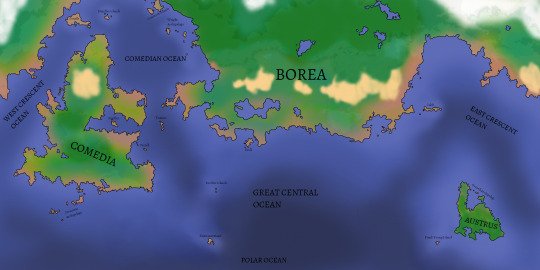
Like Earth, most of Athyrmagaia's surface comprises of an interconnected global ocean with large continental landmasses. However, Athyrmagaia's continents and oceans are much more localized than the more generously distributed Earth, with the northern latitudes being mostly land and the southern latitude mostly ocean. The sea can be divided into the Great Central Ocean, the Polar Ocean, the East and West Crescent Oceans, and the Comedian Ocean. Inversely, the planet only has three continents: Borea, Comedia, and Austrus. Although the continents are few, they comprise a relatively substantial portion of the planet's surface. Borea, the biggest continent, exceeds Europe and Asia in size and is formed from two smaller continental units (Macroborea and Microborea). It is so large that it wraps around almost the entirety of the northernmost latitudes, and the mountain range that forms the border of its larger and smaller regions runs straight through the north pole. Its smaller western neighbor, Comedia, still exceeds most of Earth's other continents in terms of scale, including Africa. On the opposite end of this scale is Athyrmagaia's only southern hemisphere continent, Austria. It is the smallest continent, so much so that it has less surface area than Australia. The rest of the southern hemisphere, save for the southernmost portion of Comedia and a few islands, is almost entirely marine, and the south pole is essentially in the middle of the ocean.

Athyrmagaia's atmosphere is nearly identical to Earth's. In terms of composition, it is about 78% nitrogen, 21% oxygen, and 0.9% argon, while the other 0.1% is comprised of other gases such as carbon dioxide and neon. It also lacks a definite boundary, and it has an average atmospheric pressure of 1013.25 millibars at sea level. This means it is breathable for Humans, and the surface can be explored without a pressure suit. Similar gases are also found in the oceans, though, as expected, they are present in different quantities.
An Earth-like atmosphere and hydrosphere also means an Earth-like biosphere. Regarding chemical composition, life here is probably the most similar to Earth out of all alien biospheres known to science at this time. Not only are they carbon-based, but their biology has converged on the same macromolecules as ours, and they even encode their genetic information using DNA and RNA. This is exceptionally rare, as most known forms of carbon-based alien life often use alternative polymers for their genetics. A differing cell structure also makes us immune to Athyrmagaian pathogens, which means that a human would be able to eat Athyrmagaian food with minimal health risks.
Except for a small number of Archaean-like methanogens, a vast majority of the microbial and multicellular organisms on Athyrmagaia are aerobic respirators that use oxidative phosphorylation to produce ATP and require essential elements such as oxygen, hydrogen, nitrogen, and carbon to survive. Not only do they rely on this Terran atmosphere to live and breathe, but they also play a role in recycling and replenishing its gases. The heterotrophs ("consumers") feed on other living things as they use oxygen from the atmosphere to power their metabolism, releasing carbon dioxide as a byproduct. Meanwhile, the autotrophs ("producers") replenish this oxygen by using carbon dioxide and abiotic energy sources to produce their own food, which separates the oxygen from the carbon and reintroduces it to the atmosphere. These autotrophic forms also made the planet's water and air breathable to begin with; back before the first autotrophs and heterotrophs evolved, the oxygen content was much lower, and there were significantly larger quantities of carbon dioxide on both land and sea.
Biochemical and metabolic similarities aside, it is still quite an alien biosphere compared to our own, and there are multiple discrepancies between Earth and Athyrmagaia biology that complicate the possibilities of human habitation. While we are immune to each other's diseases, there is still a small possibility that they may adapt to infect alien cells, which means that environmental suits are still recommended for surface exploration. The "plant" life uses polylactic acid (a type of bioplastic) in addition to cellulose to construct their cuticles. This substance is indigestible to Earth animals, but many of the native organisms are well suited for dealing with it. The planet's equivalent of cellulolytic "bacteria" can break down polylactic acid using the enzyme proteinase K, which degrades the substance through hydrolysis. Some herbivorous animals are also able to produce this enzyme to assist in digesting vegetation, though most just utilize symbiotic forms of the former microbes to do so. It also just so happens that polylactic acid is highly flammable, and it releases gaseous isopropyl alcohol when it is burned with flame. Due to this, naturally occurring wildfires often release plumes of toxic gas that linger for several days before dissipating. Fortunately, most of the native fauna are highly resistant to these toxic emissions.
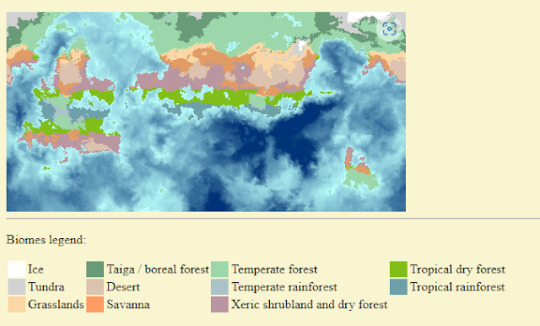
Athyrmagaia's global climate is one that us Terrans would be very comfortable in. It's global temperature is similar to that of Earth during the Pliocene epoch, and it is currently in the midst of a minor warm period that started about 2,000 Terran years ago. Unlike the artificially-induced global warming that once threatened our Earth, Athyrmagaia's warm period is a wholly natural climatic trend, and it is a result of the millennia-spanning variations in its proximity to its home star. Based on current estimates, the planet will likely enter another glacial maximum (or "Ice Age") within the next millennia, as the planet has already started cooling down slightly over the course of the past century of study.
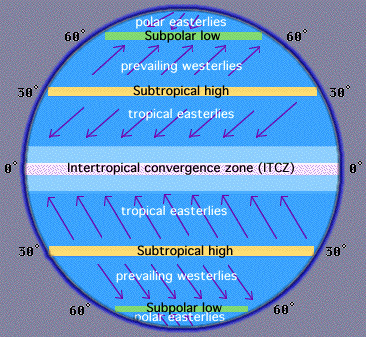
Just like Earth, Athyrmagaia's surface can be subdivided into latitudinal belts that constitute regions of relatively homogeneous climate. From the equator to the poles, these bands represent tropical, subtropical, temperate and polar climates respectively. This is because latitudes closer to the poles tend to get less direct sunlight than those in the tropics. Some of the other major determining factors of regional climate and weather on Athyrmagaia are atmospheric and oceanic circulation; Tropical and polar easterlies in higher and lower latitudes blow from the east, while prevailing westerlies in middle latitudes blow from the west, which distributes both warm and cool air across the land and sea. Oceanic currents also play a part in this process, bringing precipitation from the tropics to higher and lower latitudes. These phenomena, combined with the varied topographical features of landmasses, forms a wide variety of biomes. The poles are capped with ice and tundra, while the equator forms a belt of steamy jungle. Subtropical latitudes form dry forests, shrublands, deserts and savannahs, and the temperate latitudes consist of forests, steppes, and taiga.
As a result of its 24.2-degree axial tilt, Athyrmagaia is also a highly seasonal world, with springs, summers, autumns and winters that become more noticeable as you travel further away from the equator. The seasons of the north and southern hemispheres are opposite to each other; In the northern hemisphere, the year starts with winter, which is followed by spring, summer and autumn until it cycles back to winter at the end of the year. In the southern hemisphere, the year instead starts with summer, which is followed by autumn, winter, and spring and then ends with summer once again. At the equator, however, no such seasons exist, with there instead being two wet seasons and two dry seasons. Larger climatic trends have also occurred as a result of variations in the axial tilt and proximity to the sun over the course of millions of years, such as the current warm period.
32 notes
·
View notes
Text
Silurian Speculative Ancestry
Edit: Updated to reference Suminisans
Prelude – Meta-Origins of Silurians
It is of note that the Silurians, upon original development, were very much intended to effectively be ‘dinosaur people’. With their reptilian appearance being indicative of the pre-Avian, pre-Jurassic Park reptilian dinosaur conception. Though with JP-style avian dinosaurs being depicted in both Dinosaurs on a Spaceship and Deep Breath among others, as well as the newer designs of the Silurians themselves, make such an origin retroactively very tenuous in Universe.
Their two names from their first couple of stories, ‘Silurians’ and ‘Eocenes’, reflect two eras of history in which they are implied to originate, though both raise massive chronological problems with regards to how their depicted, especially in later works but even in their early ones. The Silurian era (444-415 million years ago) predates the emergence of reptiles entirely (310-320 million years ago) whereas the Eocene (56-34 million years ago) postdates the Dinosaurs but also still predates humanity (300,000 years ago), the homo genus (2.8 million years ago) and Hominids (22 million years ago).
And the ‘Silurian dating controversy’ only gets worse the more Silurian stories got written over time, as various pieces of media date them anywhere between less than 1 million years ago to 65 million years ago to 1 billion years ago (Which is pre Multicellular life). This exacerbated by the idea that the Moon’s capture was the reason for the Silurian hibernation, a theory that was since superseded by the Theia impact theory in modern scientific consensus and either way would have been dated to the early Solar System.
Thus for the interest of Speculative Biology I have thrown out all specific absolute dates and specific geological events associated with the Silurians in favour of hashing together an origin that makes conceptual sense for the Silurians as a prehistoric sentient Earthbound species based on what knowledge of modern biology I happen to have, as well as what jives with the overall ideas of the DWU.
Speculative Evolution


Speciation
Template
Scientific Name – Colloquial Identifier for this writeup (DWU Name/Origin Story)
Genus
Bipeslacertia – Reptilian Kindred, Suminisans (Credit Tara) (Earth Reptiles)
Species
Bipeslacertia vehemenus – Primitive Ancestor (Primitive Ancestor)
Bipeslacertia volans – “Winged Kindred” (Winged Earth Reptiles)
Bipeslacertia diabolus – Sea Devils, Aquatic Kindred (Sea Devils)
Bipeslacertia homines – Silurians (Silurians, Eocenes)
Mondasian Parallel Evolution
Bipeslacertia diabolus abastrius – Sea Kings (Mondasian Sea Devils)
Bipeslacertia homines abastrius – Lizard Kings (Mondasian Silurians)
Subspecies (Winged Kindred)
Bipeslacertia volans mortuus – “Paleocenes” (Winged Species – Adolescence of Time)
Bipeslacertia volans malakhi – Wyrm Callers (Wyrm infected Paleocenes)
Bipeslacertia volans vivus – Luadans (TM: A Morphology/Reign of the Reptiles)
Bipeslacertia volans aurori – Zori (Reign of the Reptiles/Revelry of the Redacted)
Subspecies (Sea Devil)
Bipeslacertia diabolus sicutsimiae – Late Sea Devils (Comic Sea Devils)
Bipeslacertia diabolus sicuturtus – Early Sea Devils (Normal Sea Devils)
Bipeslacertia diabolus reditius – “Devolved Ones” (Inhabitants of the Nameless City – HP Lovecraft/Faction Paradox)
Subspecies (Silurian)
Bipeslacertia homines malus – Serad-dur (Serad-dur)
“Scholar” Caste
Bipeslacertia homines augurius – Fair Folk (Fair Folk- The Shadows of Avalon)
Bipeslacertia homines sapentia – “Senior” Silurians (Chibnall’s original classic style redesign – Cold Blood)
Bipeslacertia homines rostrata – “Middle” Silurians (Warriors of the Deep Silurians)
Bipeslacertia homines gravius – “Horned Kindred” (Bulky Horned Herbivorous Silurians – TM A Morphology)
Bipeslacertia homines labia – “Early” Silurians (Original Classic Who Silurians)
Bipeslacertia homines venefica – The Silurians from the 30th Anniversary Calendar
“Warrior” Caste (Alternatively “Hunter” Caste)
Bipeslacertia homines anguis – “Junior” Silurians (Silurian Hunters – Supremacy of the Cybermen)
Bipeslacertia homines sapiens – “Late” Silurians (New Who Silurians)
Bipeslacertia homines facultatem – “Alternative Future” Silurians (Rubathon Blue)
Notes
Bipeslacertia vehemenus is considered by the Reptilian Kindred to be an ancestor species and not part of the ‘Reptilian Kindred’ themselves, it is however considered to be in the same genus biologically.
Bipeslacertia volans mortuus was the earliest sapient subspecies to diverge from the Reptilian Kindred and the first to develop a civilisation, but was however rendered extinct by the Wyrm (Alongside the Wyrm mutated Bipeslacertia volans malakhi)
The Reptilian Kindred consider themselves to have five extant ‘Classes/Castes’
Sea Devil
Scholar
Warrior
Winged Kindred
Serad-Dur
And do not consider any greater subgroupings such as the ‘Silurian/Sea Devil two species grouping’ or the ‘Scholar/Warrior single species hypothesis’ as valid, from their perspective, the five main classes are considered the maximal groupings of Reptilian Kindred outside of the sole group that includes all of them, with the term ‘Silurian’ (Alternatively Earth Reptile or Saurian) being used to refer to all five rather than just the Scholar and Warrior castes.
The original Reptilian Kindred diverged from the ancestor of the Helodermatidae family of venomous lizards in the late Cretaceous, with the Bipeslacertia genus itself diverging from the rest of the family with the origin of its bipedal stance in the early Paleocene, just after the KT Extinction Event.
Most accounts of Reptilian Kindred-Dinosaur cohabitation are either later palimpsests (The Reptilian Kindred were a time active power during the Time Wars era, with an individual of Bipeslacertia homines sapiens appearing in the Alliance of Races alongside Rassilon) or instances of Reptilian Kindred bioengineering in the Eocene and Oligocene rather than true Jurassic-Cretaceous era native Reptilian Kindred species.
Their technological civilisation emerged in the Eocene, after the divergence between the “Scholar” and “Warrior” castes of Silurians but before full speciation.
Their full classification is
Domain: Eukaryota
Kingdom: Animalia
Phylum: Chordata
Class: Reptilia
Order: Squamata
(Potential Clade: Toxicofera)
Suborder: Anguimorpha
Infraorder: Neoanguimorpha
Clade: Monstersauria
Family: Bipeslacertidae
Genus: Bipeslacertia
The emergence order of distinct subspecies was as follows
Cretaceous (145-65 mya)
Split of Bipeslacertidae from Helodermatidae
Paleocene (65-56 mya)
Bipeslacertia splits from the rest of the (extinct) Bipeslacertiadae genera, they are separately characterised by their bipedal stance as opposed to other lizard species.
Spilt of ancestor species from the rest of Bipeslacertia
Bipeslacertia volans splits from the rest of Bipeslacertia
The Zori split from Bipeslacertia volans before the full development of wings
Silurian-Sea Devil Split
“Paleocenes” split from Bipeslacertia volans, “Paleocene” civilisation forms (mostly) above the clouds.
“Paleocene” extinction at the hands of the Wyrm
Reptilian Kindred Civilisations first form.
Extinction of ancestor species
Eocene (56-34 mya)
Serad-Dur split from Silurians
“Early” and “Late” Sea Devils Split
Scholar-Warrior Split, emergence of Scholar Third Eye
Reptilian Kindred Civilisation reaches technological level
Fair Folk Split after Silurians are transported to Avalon
Oligocene (34-23 mya)
“Senior Silurians” split from Scholar caste
Scholar Caste splits into “Early” and “Middle” Silurians
The Inhabitants of the Nameless City split from the “Early” Sea Devils and devolve, eventually disappearing entirely under the shallow seas of north Africa.
“Junior” and “Late” Silurians split
Miocene (23-5.3 mya)
Speciation begins to slow down due to civilisation technological advancement
Reptilian Kindred civilisation enters hibernation due to disaster (Either the newest Moon or a planetoid close passage unrelated to the Moon)
Pliocene (5.3-2.6 mya)
Various apes modified and bred by the Reptilian Kindred begin to develop to fill the ecological niche left by the Reptilian Kindred’s hibernation.
Pleistocene (2.6 mya – 11,700 ya)
Evolution of Homo Sapien Sapiens (humans).
Holocene (11,700 ya – 1712)
Various sporadic reawakenings that are almost always killed off by the newly developed humans.
1500 BCE – Atlantis is destroyed, the Nameless City is forced above the ocean in Africa and the inhabitants are rendered (mostly) extinct
Anthropocene (1712 – 500,000 yf)
2023 AD – The origin era of Rubathon Blue of the Fifty Second Hemisphere Hatchlings in an alternative future
(22nd Century) Reptilian Kindred civilisation reawakens and is forced to cohabitate the planet with the human civilisation.
Relinquecene (500,000 yf – 2 myf)
Reptilian Kindred and humanity mostly abandon Earth for the first significant geological time (Previous abandonments had happened temporarily for much shorter timespans), whilst they would make sporadic returns, from this point onwards the Earth was allowed to evolutionarily develop without its previous intelligent species. (This is when the Haemovores evolve)
Perdicene (2 myf – 10 myf)
Earth was lost, and began being known by different names including Ravalox, Orphan 55 and Tellus. This is the point in which the Reptilian Kindred became no longer tied to Earth as a homeworld beyond as a cultural factoid (Unlike humanity who consistently returned and remained conceptually tied to it until its destruction in 10 myf and the start of the Posthuman era).
This document for the most part, only covers the Extant subspecies of Reptilian Kindred and does not account for the unknown species and subspecies that went extinct prior to the Anthropocene (nor the other extinct Bipeslacertiadae genera) with the exception of Bipeslacertia vehemenus, identified only due to Vastra’s devolution into one during ‘The Evolution Episode’ due to exposure to temporal radiation, Bipeslacertia volans mortuus, an early intelligent extinct species documented by Bernice Summerfield and Peter Summerfield and Bipeslacertia homines facultatem caused by the Fifteenth Doctor’s alterations to the evolutionary history of the Earth.
The Mondasian Parallel Evolution species (The Lizard Kings or Bipeslacertia homines abastrius and Sea Kings or Bipeslacertia diabolus abastrius) which were documented by both the Homo Sapien contra (Mondasians) and the Mondasian Cybermen are considered to be parallel evolutionary counterparts of their Earth twins and aren’t included, it is speculated their evolutionary tree is identical to that of Earth’s.
Despite being considered distinct castes by the Reptilian Kindred, the ‘Early’ Sea Devils (The Sea Devils), the ‘Middle’ Sea Devils (Warriors of the Deep) and the ‘Late’ Sea Devils (Legend of the Sea Devils) are considered to all be local or climate variations of the same subspecies of Sea Devil, Bipeslacertia diabolus sicuturtus.
I basically ignored most direct years given in DWU sources when doing this in favour of trying to work out something that conceptually made the most sense (IMO). Since DWU sources give Silurian origin or even civilisation years as far back as 450 mya, in the Ordovician, Pre-Reptiles, which is not conducive to trying to actually do speculative biology with, and the less said about 'They predate complex life entirely' the better.
I went with Eocene - Miocene because references to the Dinosaurs can always have been post-Cretaceous genetic engineering stuff (They have the tech) but references to "apes" should be theoretically constrained to early human evolution in the Miocene and Pliocene, and the idea that the Silurians existed for the entirety of the Ordovician, Silurian, Devonian, Carboniferous, Permian, Triassic, Jurassic, Cretaceous, Paleocene, Eocene, Oligocene and Miocene was... kinda ridiculous IMO for this exercise.
Subspecies Visualisation
Bipeslacertia vehemenus – Primitive Ancestor (Primitive Ancestor)

Subspecies (Winged Kindred)
Bipeslacertia volans mortuus – “Paleocenes” (Winged Species – Adolescence of Time)

Bipeslacertia volans malakhi – Wyrm Callers (Wyrm infected Paleocenes)
[No visualisation]
Bipeslacertia volans vivus – Luadans (TM: A Morphology/Reign of the Reptiles)
But the wreck, first seen from the air by a migratory tribe of the flying kindred en route from the tropical swelter of the Oriental Archipelago to the temperate climes of the Austral Spur, had confirmed to the profile of no known vessel from any of the saurian kindred, and Morrahaurm had been the only specialist available. And so, with many misgivings, she had embarked.
(Winged Kindred - The Book of the Enemy)
The globe was held by a creature like a mythical devil incarnate! Its oily green, needle-fanged head hovered just above the luminous sphere, the hellish red eyes darting from side to side in search of the intruder; and where the shoulders should have been were hunched lumps that made the man think of folded wings. The body and shuffling feet were invisible; the claws appeared in silhouette on the surface of the globe that the monstrosity held before it.
A little it resembled a gigantic lizard, and the fanged snout, if not the same one, was at least practically identical with the one Sanders had seen in the room of horror. Only now it had lost its super- natural and diabolical aspect, appearing still hideous but only in a reptilian, scaled way. It propelled itself on hissing, leathery wings, and its sinuous body was clad in a blue, silken robe. About its ugly brow was a jewelled diadem; its claws were alight with jewels.
(Luadans - Reign of the Reptiles)
Bipeslacertia volans aurori – Zori (Reign of the Reptiles/Revelry of the Redacted)
He was a Zori, a subspecies of the Reptilian Kindred with vestigial wings on their backs that were useless on Earth, but perfectly adapted to low- gravity environments.
Revelry of the Redacted (The Book of the Snowstorm)
Subspecies (Sea Devil)
Bipeslacertia diabolus sicutsimiae – Late Sea Devils (Comic Sea Devils)

Bipeslacertia diabolus sicuturtus – Early Sea Devils (Normal Sea Devils)
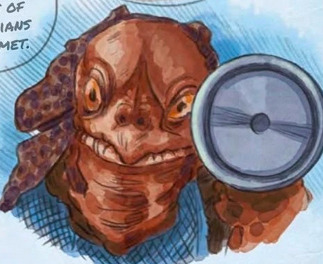
Bipeslacertia diabolus reditius – “Devolved Ones” (Inhabitants of the Nameless City – HP Lovecraft/Faction Paradox)
They were of the reptile kind, with body lines suggesting sometimes the crocodile, sometimes the seal, but more often nothing of which either the naturalist or the palaeontologist ever heard. In size they approximated a small man, and their fore-legs bore delicate and evident feet curiously like human hands and fingers. But strangest of all were their heads, which presented a contour violating all know biological principles. To nothing can such things be well compared - in one flash I thought of comparisons as varied as the cat, the bullfrog, the mythic Satyr, and the human being. Not Jove himself had had so colossal and protuberant a forehead, yet the horns and the noselessness and the alligator-like jaw placed things outside all established categories.
Subspecies (Silurian)
Bipeslacertia homines malus – Serad-dur (Serad-dur)
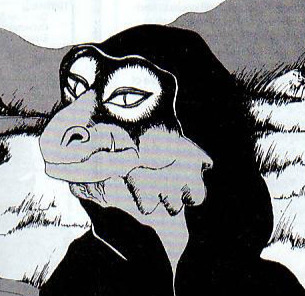
“Scholar” Caste
Bipeslacertia homines augurius – Fair Folk (Fair Folk- The Shadows of Avalon)
[No Specific Description]
Bipeslacertia homines sapentia – “Senior” Silurians (Chibnall’s original classic style redesign – Cold Blood)
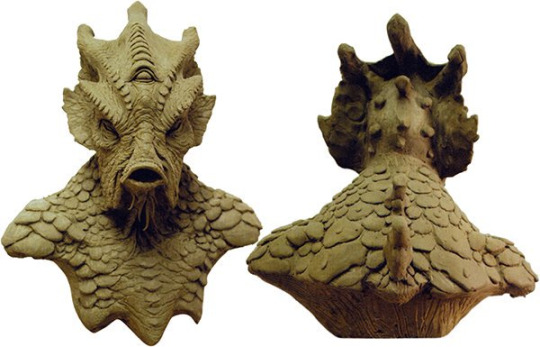
Bipeslacertia homines rostrata – “Middle” Silurians (Warriors of the Deep Silurians)

Bipeslacertia homines gravius – “Horned Kindred” (Bulky Horned Herbivorous Silurians – A Morphology)
Her mass alone would have made Morrahaurm the most conspicuous individual on board, even without the horns and crest majestically adorning her high forehead. Among her own she was known as a beauty, a graceful dancer and no mean athlete: here she was simply a bulky, lumbering target.
(The Book of the Enemy)
Bipeslacertia homines labia – “Early” Silurians (Original Classic Who Silurians)

Bipeslacertia homines venefica – The Silurians from the 30th Anniversary Calendar

“Warrior” Caste (Alternatively “Hunter” Caste)
Bipeslacertia homines anguis – “Junior” Silurians (Silurian Hunters – Supremacy of the Cybermen)
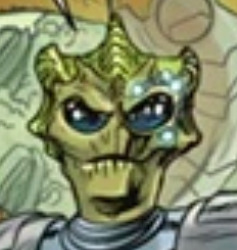
Bipeslacertia homines sapiens – “Late” Silurians (New Who Silurians)

Bipeslacertia homines facultatem – “Alternative Future” Silurians (Rubathon Blue)

Notes on the Meta-history of Earth Reptiles
The natural evolution of most species on Earth was a by-product of the anchoring of the thread, when the Time Lords locked down the rational Universe and rewrote all of history to suit their new rules. In the pre anchoring Universe, humanity was created using Time Lord Looms by the Original Mammoths, a powerful, psychic and magical sapient species that rivalled the Time Lords in the pre-Universe.
Whilst we have pretty much no knowledge of the Silurians from that era, we do know that they were a Time Active power in the Alliance of Races during the Time Wars era, shortly after the anchoring. Implying some kind of time active power, which would explain their appearances in eras of Earth history predating the one in which they originally developed in the Time Lord dominated rational Universe. It is, however, also of note that the vast majority of other more recent (in Universe) accounts depict the Silurians as a mildly advanced mostly stagnant species with very little space travel capabilities most likely indicating at some point between Gallifrey’s ancient past and relative present that the Silurians time active civilisation was erased from history. It is possible they experienced some equivalent of the Ghost Point (The point in which humanity became culturally sterile and stopped meaningfully advancing as a civilisation) though more extreme as humanity was still able to traditionally, if not conceptually, advance whereas the Silurians grew complacent and stagnant for presumably millions of years.
It is of note that New Who consistently depicts the Silurians as both coexisting natively with Dinosaurs and knowing humanities Ape ancestors despite an ~60 million year gap between the two eras. There are numerous potential explanations for this including human evolution occurring over a much longer period in the DWU relative to real life, the effects of the Last Great Time War on the history of Earth, genetic engineering resurrection of Dinosaurs in the Eocene-Miocene and potentially Silurian related dates being actually in months rather than years.
#doctorwho#doctor who and the silurians#silurians#sea devils#faction paradox#book of the enemy#speculative evolution#but like only loosely#cause this is still DW and DW is weird#feel free to use#earth reptiles#doctor who speculative evolution#Eocenes#doctor who fasa#doctor who titan#classic who#new who#nuwho#dr who#idk how tags work#reign of the reptiles#The Book of the Snowstorm#Revelry of the Redacted#Yes there's Silurian Lore in the book now#Wonder Stories#Rubathon Blue#Ruby Sunday#Space Babies#Is Rubathon a Silurian?#Im assuming yes for now
44 notes
·
View notes
Text

Has Noah's Ark Been 'Found'?
Researchers may have found the final resting place of Noah's Ark, with the Biblical boat mound now researched by experts taking a series of samples to prove whether the boat was left there.
Noah's Ark may have been found after experts uncovered a 5,000-year-old mound of a boat-shaped object.
New images from scientists working hard and wondering whether they found the Biblical vehicle show a massive mountain with space for a boat-like object in Turkey.


A team excavating geological locations in the country believe rock and soil samples could show they contain remnants of a vessel which took two of every animal during a flood of the world.
Archaeologists concluded the site was around the area the Bible references from almost 5,000 years ago, with the mound mentioned in the Book of Genesis. Ararat, now eastern Turkey, is believed to be the resting spot of the Ark.
Ongoing since 2021, the project is still determining samples of clayey and marine materials, as well as seafood found nearby. The highest peak in Turkey, standing at 16,500ft, could be the resting spot of the Ark's ruins.


According to researchers, human activity was present on the boat-shaped mound between 5500 and 3000 BC, The Sun reported. The formation is now believed to be the site of the Biblical boat, which researchers have so far collected 30 potential samples of.
AICU Vice Rector Professor Faruk Kaya said: "According to the first findings obtained from the studies, there have been human activities in the region since the Chalcolithic period between the years 5500 and 3000 BC.
"It is known that the flood of Prophet Noah went back 5,000 years ago. In terms of dating, it is stated that there was life in this region as well. This was revealed in the laboratory results.


It is not possible to say that the ship is here with the dating. We need to work for a long time to reveal this." Though considered a historical event, most archaeologists and scholars do not believe the literal interpretation of the Noah's Ark story.
The Biblical story, which sees God demand Noah to construct an Ark to survive a future mass flood as he was the only righteous man worth saving on the planet, is not currently believed by scholars. They do believe, however, the mound could be where the Ark was left.

#Has Noah's Ark Been 'Found'?#ararat turkey#Book of Genesis#Prophet Noah#ancient artifacts#archeology#archeolgst#history#history news#ancient history#ancient culture#ancient civilizations
43 notes
·
View notes
Text
Have you ever wondered how scientists know what earth's climate was like in the past? Thousands of years ago, long before humans started to measure and record these things?
It's a really fascinating question with a VERY cool answer! Ice cores! Basically, they go to someplace cold, like the Arctic or Antarctic, and drill really deep into the ice to take a vertical section of it.
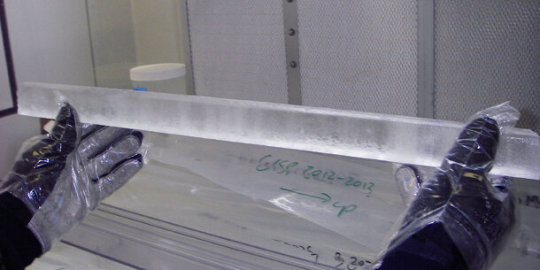
[ID:A cylinder of ice, about an inch in diameter and perhaps a little over a foot long (that's around 2.5 centimeters in diameter and over 30cm long, for those of you sensibly using the metric system), held in thickly-gloved hands. End ID.]
Here's what they look like. Kind of - they're a lot bigger when they come out of a glacier, but they get broken down into smaller pieces for transportation and study.
The US National Oceanic and Atmospheric Administration has a cool article on it here, but I'll go over the basics because tumblr science communication has a uniquely fun dialect, and I much prefer to learn things that way. I'm also putting it under a read-more because it got long.
If you've ever taken a geology class, you probably know that rock gets deposited vertically over time, with the newest at the top and the oldest at the bottom. In places where ice stays frozen for a long time, it's basically the same principle - year after year of snow and ice layered on top of each other. Ice cores can include stuff that's been frozen for perhaps thousands of years - including air bubbles, dust, sea salt, volcanic ash, etc. Both those and the ancient ice itself can tell us things about what earth's climate was like when they were first frozen.
The water in the ice cores contains, just like water from today, varying ratios of oxygen isotopes: oxygen-16 and oxygen-18. Remember, the difference between isotopes is the number of neutrons in each atom - oxygen-16, with 16 neutrons, is the 'normal' one, which makes up over 99% of oxygen atoms. It's also lighter than oxygen-18, which has two extra neutrons, and that means that it's slightly more difficult to get out of the atmosphere via precipitation - and this is easier at colder temperatures. So, as global climate gets cooler, the ratio of oxygen-16 to 18 increases, and as global climate cools, it decreases. We can measure those ratios in ice cores to figure out what Earth's climate was like in the past - as far back as we can find ice. How far is that? Up to 800,000 years. Yeah, that's some fucking old ice.
That's a lot of ice, I can hear you thinking. You're right - the deepest ice core ever collected was 3769m - 3.7 kilometers of ice (for my fellow Americans, that's over 2 and a quarter miles). That is a stupidly long piece of ice. Now you know why they have to break it up to analyze it.
Also, remember those air bubbles I mentioned? We can measure the concentrations of gases in those to learn about the composition of Earth's atmosphere a long fucking time ago, including the concentration of greenhouse gases like carbon dioxide and methane. (How do you get air bubbles out of ancient ice you ask? NOAA has the answer: crush it under a vacuum hood. That means there's no other gases around to contaminate your sample while you put it in an airtight vial.)
How do we know how old the ice is? Same way we date other ancient stuff - there's two main methods.
Radioactivity and radioisotopes! Mostly naturally occurring, although for recent ice, radioactivity from nuclear testing can also be used. Carbon dioxide can be radiocarbon dated, volcanic material can be argon/argon dated, etc.
Layering! Especially looking for distinctive stuff like volcanic ash from significant geological events. This can be used to synchronize ice cores from different places, or for relative ages (i.e. this section is older than this one).
These are far from the only things ice cores can teach us, but this post is already very long so I'll leave it here. Check out the NOAA article for more details, and a fun anecdote about how no fieldwork project ever goes entirely according to plan - especially when there's polar bears.
Sources: 1, 2
#hylian rambles#hylian does science#science side of tumblr#climate change#ice cores#science education#i should do a followup post about the history of atmospheric greenhouse gases sometime#dig into some actual ice core data. because it blew my mind when i first saw it and i'm sure it'll blow yours too.
11 notes
·
View notes
Text
Are you going to celebrate BIF's Birthday?
At the start of this year, I decided to create a geologic calendar.
Basically, I've heard an analogy in geology classes that if you compressed all of geologic time into a year, X thing would happen on this day, with all of human history happening as a tardy entry to the New Years Eve party.
The formation of the moon was early in the year, on January 6th.
Mid February was the beginning of the Archaen.
From June 16th to July 20th this year marks the Great Oxidation Event (2.46-2.06 Gya). (Estimates for the start date vary, and it could be as far back as today, June 13th)
During this event, our atmosphere went from being almost devoid of Oxygen to having the concentration that we can breathe today. This was likely due to conditions becoming favorable for photosynthetic cyanobacteria, which gave off oxygen as a by product. As the oxygen was produced, it reacted with iron dissolved in the seas, becoming insoluble iron oxide, which settled out on the ocean floor in mass quantities. This is the Banded Iron Formation (BIF), which forms much of the world's red beds and iron ore.

So for the next few weeks, when you take a breath of fresh air or use something made of iron, remember that it could very well be a sort of birthday.
Happy geo anniversary BIF
10 notes
·
View notes
Text
Let's talk science. Here are my top 10 reasons why I reject the Nation of Islam's belief that the Moon was made 66 trillion years by an evil Black Scientist, who dug near the center of the Earth, filling it with dynamite and separating the Earth from the Moon.
1. Due the extreme temperature and pressure, it's virtually impossible to dig anywhere near the Earth's core. We barely had the technology to drill 7.5 miles below the Earth's surface before the drills overheated and broke. For the NOI Moon deportation belief to be true, without any empirical evidence, we would have to ASSUME that the technology existed.
2. Radiometric dating of the Earth, Moon, Mars, meteorites, in fact most of the material in Solar System, dates back to roughly 4.5 billion years ago. This is one reason scientists think our Solar System formed from the same collapsed cloud of gas and dust about 4.6 billion years ago. For the NOI Moon deportation belief to be true, without any empirical evidence, we would have to ASSUME the Solar System is far older ("trillions of years ") than the data show.
3. Archaeological and genetic evidence suggests the age of anatomically modern Homo sapiens is about 200,000 to 300,000 years old. For the NOI Moon deportation belief to be true, without any genetic or fossil evidence, we would have to ASSUME that humans have existed for trillions of years.
4. The object that impacted the Earth 66 million years ago, partly responsible for the extinction of the dinosaurs, released more kinetic energy than almost any other event in Earth's history. The Chicxulub meteor imoact released 100 Teratons of TNT. But it was not sufficient to overcome the gravitational binding energy between the Earth and the Moon.
In contrast, the energy released by the Mars-size bollide ("Theia") that separated Luna from Earth was equivalent to 8,000 Teratons. This means it was about 80 times more energetic. 1 Teraton is equal to the energy released when detonating 1 trillion tons of TNT. So, 8,000 Teratons would be the energy equivalent of 8,000 trillion tons of TNT. That's the weight of about 50,000 Mt. Everests.
For the NOI Moon deportation belief to be true, without any empirical evidence, we would have to ASSUME someone had the expertise, equipment, materials, manpower and facilities to transport and store this amount of TNT. Even then, it would take several decades (or longer) to produce.
5. Gunpowder is a mixture of potassium nitrate, charcoal and sulfur. Dynamite is primarily nitroglycerin and some sort of absorbent material (like clayshells, or sawdust). Moondust, on the other hand, is composed of silicon dioxide glass, plus iron, magnesium, calcium and other trace materials. No lunar rocks or soil samples taken from the Moon contained any trace of explosives, gunpowder, or any artificial, man-made substances whatsoever. For the NOI Moon deportation belief to be true, without any empirical evidence, we would have to ASSUME either a.) traces of gunpowder does exist in the Luna rock and soil, we just haven't detected it yet or b.) scientists have discovered but there is a global conspiracy to conceal it.
6. The impact craters from comets and asteroids bombarding the lunar surface have a frequency and distribution that's consistent with a 4.5 billion year model of the Solar System, not a 66 trillion one.
7. Tidal forces, from the gravitational interactions between Earth and Moon, are causing the Moon to recede from the Earth at a rate of roughly 1.5 inches per year. This is approximately the rate our fingernails grow.
Over the course of trillions of years, the gravitational forces would have weakened significantly as the distance between the Earth and the Moon increased far beyond what it currently is today. Eventually, this weakening of gravitational forces would have lead to a gradual reduction in the rate of tidal transfer of angular momentum. However, the geological records (preserved in ancient tidal rhythmites in sedimentary rocks formations) do not reflect trillions of years. We also put retroreflectors on the Moon during the Apollo missions, so we can use laser ranging to measure the distance from Earth to Moon with precision and the measurements are consistent with a theoretical model of the Moon being 4.5 billion years, not 66 trillion years.
8. Our Sun is a yellow dwarf. A G-type main-sequence star and is about 4.6 billion years old. It's age was measured by radiometric dating of meteorites, isotopic information, and from observing the life cycle of other stars in the Universe. Based on our understanding of stellar evolution, the Sun will exhaust its hydrogen fuel in about 5 billion years and become a red giant star.
If the Sun were "trillions" of years old, it would have already exhausted its hydrogen fuel, travelled through all of the stages of stellar evolution, from yellow dwarf to red giant to planetary nebula to white dwarf and, finally, a cold, dark object called a Black dwarf.
9. If the Earth were "trillions" of years old, then we would see evidence of that in the fossil record, archeology, geology, climate, ocean sediments, genetic, paleontology, etc. We don't. Everything we discover is consistent with a 4.5 billion year old planet.
10. Cosmic Microwave Background Radiation, the redshift of galaxies, the fact that the farther away a galaxy is from Earth, the faster it appears to be moving away (Hubble's Law), and many other forms of observational evidence (gravitational lensing, stellar evolution, nucleosynthesis) serve as signatures of the universe expanding from a small, hot dense state about 13.8 billion years ago. We would not expect to see, nor could we explain, these phenomena, if the universe was trillions of years old.
By Supreme Scientist Allah (facebook)
#nation of gods and earths#five percent nation#supreme mathematics#allah school in mecca#hip hop#5% nation of gods and earths#black women#father allah#nation of islam#Elijah Muhammad#black people#scientist#scientific research#black men#black owned businesses#underground hip hop#rappers
8 notes
·
View notes
Text
saw the cat person movie with @drdemonprince last night, a truly national event, and while definitely like, artistically and craft-wise a bad movie, it was a treat for a couple people who did not like the short story at all - the interesting, charming, and intriguing things about it, though absolutely not done on purpose, really underscored the dysphoria between the reader reaction to the short story itself and the reality of the writing (bad)
1 - the short story came out in 2017! I'd only been in chicago for 10 months! truly this was a geological age ago.
2 - the twitter discourse on the publication of this short story was more encompassing and wild than the short story itself. people compared it to "the lottery". people called it "the first viral short story". people called it haunting and twisted and nasty and trenchant and intense. the extreme blurbage really set it up for a vaster failure to me specifically (the only opinion that truly matters) when I read it and thought it was like, a kind of dull story with listless characters.
3 - short stories have been adapted before! Frank Perry did The Swimmer back in the sixties! He had Burt Lancaster! (don't know where I was going with this - I think was going to say an actually literally wise director can adapt cleverly from brief material, but then I remembered I have not actually watched The Swimmer yet and probably shouldn't say that in good faith)
4 - so anyway - and once again, I think this was absolutely done unintentionally, so not 'good' per say - Cat Person The Movie portrays yes, the text of the short story, but due to both the deficiencies in the text and the deficiencies of the filmmakers, forces itself to literally play out the fantasies of the mass reader reception, fantasies that arguably swallowed the actual short story itself - that this was a chilling portrayal of modern dating/war of the sexes/misogyny/male violence, etc.
5 - I believe these fantasies happened because, 1, a lot of people aren't textually very wise. it is truly fandom bullshit. people have an intense emotion from deficient text or content and then start squeezing blood from stone and things snowball from there
6 - while, once again, I say, the movie most definitely not doing this shit intentionally, it had enough awareness for the usual tongue-in-cheek stuff, not because this was "the good thing to do craft-wise" but because tongue-in-cheek awareness is de rigueur these days, and because the adaptors, though maybe not craft geniuses, have the pragmaticism of Movie/Film People and were like "we absolutely do not have enough shit to go off on" and, again unintentionally, squeezed blood from stone just like the readers from yesteryears and managed to beautifully mimic the mass delusion that surrounded, again, this fucking bad and boring short story and managed to bring some actual violence to the table
7 - due to the fact that this is a Film with Actors and had Moving Visual Images, it benefited from like, you know, some of the actors being charming and kind of funny
8 - the story came out, again, in 2017, the stone ages, and modern dating and the twitter lit scene has gone through several more geological cycles since then, so the whole thing felt just a little old fashioned. the salad days!
9 - the ending close up on Margot's shit-im-nutting face when the second guy asks her out at the movie theater is such a fucking funny choice and departure on the og story, that this girl is now addicted to the rush of thinking every dude she dates is going to stalk/kill/drug her - (and she's correct! robert was, apparently, willing or contemplating to do two out of three of those things! but also - maybe she's crazy too and, you know, kind of deserves it?) like, such a hysterical and cynical choice, masterstroke.
10 - bad story! (no stars)
11 - bad movie! (five stars, would see again, love and light to all)
12 - The Swimmer (1968) dir. Frank Perry and starring Burt Lancaster is free on Tubi
18 notes
·
View notes
Text
Dragging timekeeping kicking and screaming into the 118th century
So there was this guy, Cesare Emiliani, a geologist. He studied the history of ice ages (among other things), and in 1993 he proposed a new calendar system called the Holocene Era, or Human Era. Rather than counting the years from the birth of Jesus, this system counts from the beginning of the Holocene geological epoch, which began with the end of the last ice age nearly 12,000 years ago. This is also roughly when agriculture first began to be practiced.
Emiliani's proposal was to add 10,000 to the AD date, so 1993 becomes 11993. The Holocene Era system has two main advantages: its reference point is based on an event of undeniable worldwide significance, rather than a single person that billions of people have no connection to, and it allows for much more intuitive understanding of the length of time spans that cross the AD/BC divide.
I'm a big fan of this idea. Reading about historical events with dates in the high four or low five digits makes me feel like I'm in a space opera - it's an interesting exercise in defamiliarization. How would we think about things differently if we were regularly reminded of our place as the successors to 12,000 years of historical, cultural, and technological development? (Of course, even that is only a fraction of human history - but it's the fraction in which most of the interesting stuff happened.)
I have one issue with the HE system, though - 10,000 is too round of a number. It's true that it's around when the epoch began, and any more specific number would have just been an arbitrary choice for Emiliani. But the end result is that, for dates in the last 2000 years, you can clearly see the AD system poking through, just with a 1 that feels half-heartedly tacked on to the front. (This is the same problem I have with the BCE/CE system - it doesn't actually change the reference point).
Emiliani was doing the best he could for the time, but since then, the beginning of the Holocene has been fixed more precisely at 9700 BC. Therefore, I propose the Revised Holocene Era. AD dates can be converted to RHE by adding 9700, and BC dates can be subtracted from 9701.
At this point I wanted to give a kind of overview of some important historical events of the RHE, just to give a more concrete sense of the depths of time involved. But, uh... by its very nature, that's kind of impossible. Even focusing on a specific place, or type of event, or something, would be too overwhelming to even properly begin. For now, take the following as an example: the pharaohs of Egypt ruled from 6551 to 9671 RHE, and the emperors of China ruled from 9480 to 11612 RHE. Even that only covers the back half of the era! The world we live in, with things like "houses" and "crops", was already ancient when the first pyramids were built.
Ok, so I know none of this stuff is news. Presumably, you were not under the impression that human history started 2000 years ago. It's not like we don't talk about ancient history - everyone knows the factoid about how there were still woolly mammoths when Egypt got started (until at least the year 7200!). But I still encourage you to try adding 9700 to dates you come across in the wild. Maybe it'll give you a change of perspective, and if nothing else, you can have fun pretending to be in some kind of Dune-esque far future learning about events in the slightly-less-far future - because basically, you are!
5 notes
·
View notes
Text
man this is purely hypothetical and i don't really feel like toying with it too much but like. one of the earliest known hominids (Homo habilis) lived roughly 2.4 to 1.4 million years ago (mya). members of Australophithecus, an even older genus of ancestors, have been dated back as far as 4.1 mya, and there's much much older specimens that have been identified than even those. if reaper cycles occur every 50k years, that means that there have been 82 cycles since the appearance of Australopithecus, and even more if you go back to the very oldest specimen we've identified (Ardepithecus kadabba, 5.77-5.54mya, known only from teeth and bone fragments found to have come from 17 specimens). one cycle is only 0.05my! and we're only the youngest and most recent species in m.e. canon to develop mass effect technology - the other species are thousands of years ahead of us! turians developed civilization about 7,000 years ahead of sumer!
so i'm just thinking like. there are only so many planets in the galaxy capable of evolving and sustaining life, even if it's different from how we recognize it on earth with a carbon base and breathing a nitrogen-oxygen mix. there have been 5 mass extinction events in the history of our planet, going back at least 500my. the reapers have been doing their thing for billions of years. there is a nonzero, potentially even statistically significant chance that there have been species somewhere in the galaxy that evolved on planets where there was a previous advanced, spacefaring civilization that was reaped, leaving something else to grow and develop in its place and eventually possibly be reaped in turn. the reapers could very feasibly be the source of mass extinction events in any given planet's geologic record, and that's just. utterly fascinating to me, there's SO much potential for worldbuilding there
#councilor's notes#.... these are the kinds of posts that put it into perspective why i do so much worldbuilding for alien history and evolution huh
7 notes
·
View notes
Text

Lake Erie Blooms
Algal blooms have become a common occurrence on Lake Erie, as much a part of summer at the lake as island-hopping, scenic cruises, and roller coasters. In 2024, a bloom of blue-green algae began forming in the lake’s western basin on June 24—the earliest that a bloom has been identified by NOAA since the agency began tracking them in 2002. It was still present in early September. Bloom season can last into October, with its duration depending on the frequency of wind events that mix lake waters in the fall.
When the OLI-2 (Operational Land Imager-2) on Landsat 9 acquired this image on August 13, the bloom covered approximately 320 square miles (830 square kilometers). Since that date, which was the last time Landsat satellites got a clear look at this part of the lake, the bloom would more than double in area to the season’s likely largest extent of 660 square miles (1,700 square kilometers) on August 22.
Phytoplankton blooms carry implications for the lake ecosystem, human health, the local economy, and even municipal water supplies. The dominant organism in this bloom, a Microcystis cyanobacteria, produces the toxin microcystin, which can cause liver damage, numbness, dizziness, and vomiting. NOAA’s Great Lakes Environmental Research Laboratory measured toxins at concentrations above the recreational limit the week of August 12. The agency noted that toxins can be concentrated in scums, advising that people and their pets stay out of the water near scums.
NOAA and its research partners had forecasted a moderate to above-moderate harmful algal bloom (HAB) in western Lake Erie this summer. Blooms are classified based on their biomass, and a moderate-severity bloom will produce noticeable areas of scum. However, the agency noted, a bloom’s size does not necessarily correlate with its toxicity.
“Nutrient input from the Maumee River is the dominant driver of HAB variability from year to year,” said Brice Grunert, a professor in the department of Biological, Geological, and Environmental Sciences at Cleveland State University. Other factors such as temperature, mixing of the water column, and water movement also influence the extent and duration of blooms, he said. Precipitation can increase the load of nutrients such as nitrogen and phosphorous in runoff to the lake, and warmer, more stratified water can amplify blooms. In 2024, the bloom followed a period of record April rainfall and an intense heatwave, according to news reports.
Satellite imagery plays an important role in helping scientists understand the nuances of phytoplankton blooms, which in turn can aid those charged with monitoring and forecasting the events. Grunert has been working in Lake Erie’s western basin for the past three years to better understand phosphorous cycles within the lake. His team is investigating how satellite imagery, combined with data from sediment sampling and chemical tracers, relates to the amount of algae-producing phosphorous in the water column.
He and other scientists studying aquatic ecosystems will soon have a new tool at their disposal in the form of the OCI (Ocean Color Instrument) aboard NASA’s PACE (Plankton, Aerosol, Cloud, ocean Ecosystem) satellite. This instrument measures waterbodies in hundreds of wavelengths across a spectrum of ultraviolet, visible, and near-infrared light. When fully calibrated, the data will enable scientists to track the distribution of phytoplankton and—for the first time from space—identify which communities of these organisms are present on daily, global scales.
Despite the presence of the word “ocean” in the mission title, PACE also opens new lines of inquiry in the freshwater realm. “There are a lot of interesting questions that can be addressed using PACE imagery in the Great Lakes,” Grunert said. For example, hyperspectral data will be able to reveal phytoplankton pigments that could previously only be estimated with the limited number of spectral bands, he said. And a more detailed perspective of blooms over space and time is expected to help scientists decipher how HABs in Lake Erie develop and why cyanobacterial blooms in Lake Superior are starting to occur. “This unlocks a whole new level of information that can be used to describe the unique and changing ecosystems and biogeochemistry within the Great Lakes,” he said.
Grunert is currently working on a PACE Validation Science Team project, taking field measurements in parallel to observations being collected by PACE’s OCI. These include water-surface color and the optical properties of phytoplankton, sediment, and other substances in the water column.
NASA Earth Observatory image by Wanmei Liang, using Landsat data from the U.S. Geological Survey. Story by Lindsey Doermann.
3 notes
·
View notes
Text

From Sea Stacks to Volcanic Glows: Izu Peninsula's Coastal Beauty
Location: Imaihama Beach, Kawazu, Shizuoka, Japan
Timestamp: 06:53 on February 14, 2024
Pentax K-1 II + DFA 28-105mm F3.5-5.6 + CP
28 mm ISO 100 for 1/400 sec. at ƒ/9.0
Visiting Imaihama Beach for the first time, I was pleasantly surprised to discover that a natural formation at the southernmost tip of the beach blocks the view of the large hotel right on the beach to the north. This formation allows for an unobstructed view of the sunrise, painting the sky with warm hues over the gentle waves and scattered sea stacks on the sandy shoreline.
To the left of the sea stack on the distant horizon stands Oshima Island, the largest among the Izu Islands—a cluster of volcanic islands adorning the eastern coastline of the Izu Peninsula.
Oshima has an active volcano, with major eruptions recorded in 1965, 1986, and the most recent event in 1990. My familiarity with Oshima Island dates back to the 1986 eruptions when I found myself atop Shonan-daira where I was marveled at the bright flashes and glow emanating from the volcanic eruptions and lava flow on Oshima Island, a distant spectacle at 65.04 km (40.41 mi) due south of Shonan-daira.
Whether leisurely strolling along the shores of Imaihama Beach or venturing into the coastal treasures scattered across the Izu Peninsula, keep an eye out for many of the geological marvels that collectively form the Izu Peninsula Geopark!
I have included Google Maps links to this location and have links to sites providing additional information about Oshima Island, Shonan-daira, and the Izu Peninsula UNESCO Global Geopark (https://www.pix4japan.com/blog/20240214-sea-stack).
#海景写真#伊豆半島#河津町#今井浜海岸#pix4japan#pentax_dfa28105#pentaxk1mkii#seascape photography#Japan#Izu Peninsula#Kawazu Town#Shizuoka Prefecture#Imaihama Beach
15 notes
·
View notes
Text


On 22nd February 1875 Sir Charles Lyell, eminent Scots Geologist, died.
Charles Lyell was born at Kinnordy, Angus 1797, he began his career as a lawyer, but later changed to geology. His background in zoology and the physical sciences allowed his research to cover more of a scientific scope. He believed that creation of the earth was not based on the interpretation of Genesis, but on the basis of scientific explanations. He sought a scientific knowledge of the formation of the mountains.
Lyell was also a Darwinist, and wrote of his observations in The Geological Evidence for the Antiquity of Man in 1863. Later, when he visited the Alps, he saw recognizable similarities in rocks of the Alps and Appenines. Both were made up of tertiary, uplifting rock strata.
Through his experiments on these two mountain ranges, he was able to identify the positions of the earliest seas and gulfs. He studied the glacial movements in mountains, like the Mere De Glace on Mont Blanc in the Alps, searching for a way to identify how exactly mountains were cut and formed. He also theorized a future “convulsion” that would make a new mountain range in Europe, east of the Alps.
Lyall’s greatest work was done on his Theory of Uniformism, based on his attempts to date the Alps: “Although we have not yet ascertained the number of different periods at which the Alps gained accessions to their height and width, we can affirm, that the last series of movements occurred when the seas were inhabited by many existing species of animals” (from Principles of Geology, 1863).
Uniformism meant that all of the processes in which the physical world changed in the past are also changing the physical world presently. Lyell’s theory was counter to many theories on catastrophism, which were based on the idea that the physical world was changed due to catastrophic events, like a flood, or an earthquake.
Of course all this made him quite unpopular amongst the then devout majority who believed the bible in it’s entirety, it’s remarkable that some still believe this version of events!
Although Darwin’s theories of evolution had it’s basis in some of Lyell’s work, the Scot had trouble accepting “the descent of man from the brutes,” He simply could not, as he put it, “go the whole Orang.” So although his Uniformism theories brought him condemnation from the church, he still had some sort of Faith that stopped him believing Darwin’s theories.
Charles Lyell died on 22nd February 1875 aged 77 at his home in Harley Street, London, he is buried at Westminster Abbey, his name lives on in Mount Lyell in Yosemite National Park. California; Lyell craters on the Moon and Mars; the Lyell Centre at Heriot-Watt University; and the jawless fossil fish, Cephalaspis lyell
7 notes
·
View notes